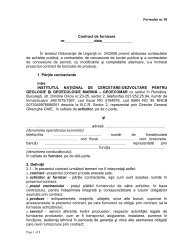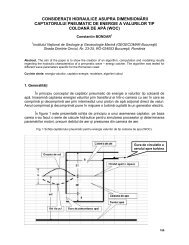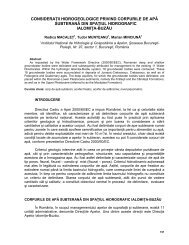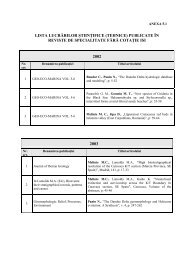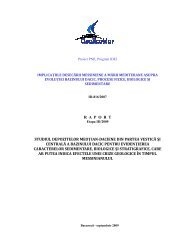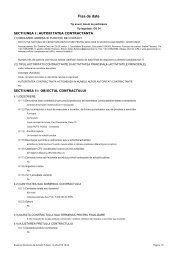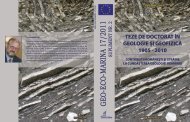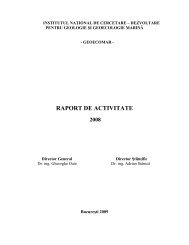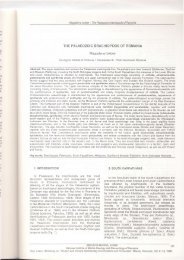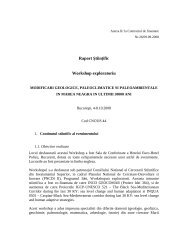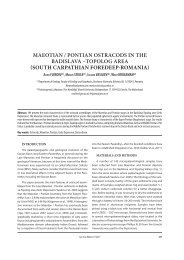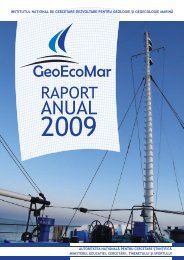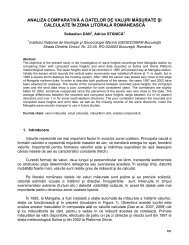DACIAN BASIN - GeoEcoMar
DACIAN BASIN - GeoEcoMar
DACIAN BASIN - GeoEcoMar
Create successful ePaper yourself
Turn your PDF publications into a flip-book with our unique Google optimized e-Paper software.
10.4. Control factors of the sediment filling process<br />
Stage 1. Brackish sediment accumulation restricted to two separated depocenters. This<br />
stage extends through the Middle-Late Sarmatian (s. l.) – Maeotian time interval.<br />
The main distinctive character of the stage 1 is the sediment accumulation<br />
within two distinct Dacian Basin depocenters (Fig. 10.10 A and B). The areas of the<br />
individual depocenters enlarged considerably during the Maeotian, as compared<br />
to the Middle-Late Sarmatian (s. l.) extent.<br />
During the Maeotian time interval the eastern depocenter extended mostly<br />
toward the south-west with a fan-like geometry (Fig. 10.10 B).<br />
The western depocenter enlarged eastward and southward, and the maximal<br />
sediment thickness increased from 200 m during Middle-Late Sarmatian (s. l.) to<br />
600 m in the Maeotian time (Fig. 10.10 B).<br />
In the space between the two depocenters a reduced amount of sediments<br />
accumulated, with around 100 m thickness.<br />
Stage 2. Brackish sediment filling, mainly through the extension of the eastern depocenter.<br />
This stage covers the time span from the Early Pontian to the Early Dacian.<br />
The characteristic of the sediment filling process during the stage 2 is the westward<br />
advance of the sediment accumulation along the sedimentary trench (Fig.<br />
10.10 C and D). The main effect of this process was the filling of the accommodation<br />
space of the former sediment deficient area between the two depocenters.<br />
In the western depocenter, the southward extension of the sediment accumulation<br />
area continued, reaching its maximum during the Early Pontian (Fig. 10.10<br />
C). The Late Pontian-Dacian isopach map (Saulea et al., 1969) shows the end of<br />
this process and the decrease of the sediment accumulation in the western depocenter<br />
of the Dacian Basin (Fig. 10.10 D).<br />
The two depocenters coalesced into a single depocenter sometimes between<br />
Late Pontian and Early Dacian. The stage 2 ends with the filling out and closure of<br />
the brackish-marine Dacian Basin.<br />
Stage 3. Fluvial sediment accumulation subsequent to the filling out of the Dacian<br />
Basin. Starting from the Middle Dacian time, the sedimentation in the area of the<br />
Dacian Basin is fluvial. The isopach map indicates a single area, with an east–west<br />
elongated sediment accumulation front (Fig. 10.10 E). The large scale geometry of<br />
the sediment accumulation, belonging to the piedmont type, indicates an exclusively<br />
Carpathian sediment supply. In contrast with the preceding sediment filling<br />
stage, the sediment accumulation tends to extend southward.<br />
10.4. CONTROL FACTORS OF THE SEDIMENT FILLINg PROCESS<br />
The history of the sediment filling in the Dacian Basin was strongly influenced by<br />
the tectonic factor. Being a foreland unit, the Dacian Basin physiography have been<br />
shaped mainly by the tectonic forces. The Dacian Basin elongation (a typical fore-<br />
225



